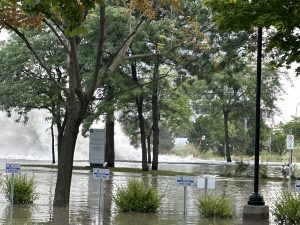Amid all the talk lately about a national infrastructure bank and the need to build more "hard" infrastructure, it’s easy to lose track of what people are calling "soft" or "green" infrastructure.
We often seem able to focus our attention on just one thing at a time, and, right now, the idea of an infrastructure bank is seen as one way to finance more "hard" infrastructure —for water filtration, wastewater treatment, roads, all that sort of stuff.
But if we’re going to build resilient cities in the face of a changing climate, we have to concentrate on a range of solutions. And many of them fall into the category of green infrastructure.
Back when we were just becoming aware that our world was warming, there was a slogan among those who wanted to do something about it: "Think globally. Act locally."
And now that we’re seeing more aberrant weather, more extreme rainfall, more drought, more of all the stuff we don’t want, we have a chance to "act locally."
The Ontario government is on record as wanting to have stormwater managed where it falls, instead of channelling it into treatment plants that can sometimes be overwhelmed.
Much of Canada’s stormwater management infrastructure is old and will soon need to be replaced. In the meantime, there are things we can all do to help keep the existing infrastructure on the job.
Some communities have begun to charge a stormwater levy, which can be based on the area of impervious surfaces on a property. If you have a large paved area, more stormwater is going to drain from your property into storm sewers and the higher the stormwater levy you’ll pay.
Requiring people to pay for stormwater that runs off their property tends to focus the mind. First, you swear at the city government. Then you start thinking about ways to reduce the runoff.
There is an organization called Green Communities Canada, which has two rain-related websites. One of them, Rain Community Solutions, has a lot to say about rain and how to hold onto it long enough to avoid sending it to your local wastewater treatment plant.
One of the things it says is that, in a forest, most of the rain that falls is intercepted by trees or soaks into the ground. Less than 10 per cent eventually runs off into rivers and streams. But when a forest turns into a city, the loss of vegetation and the increase in impervious surfaces — buildings, roads, parking lots — most of the rain that falls simply runs off as polluted waste.
The things suggested on the website aren’t new. All have been proven to help reduce runoff. They include things like rain gardens and bioswales, using permeable pavement, or installing an infiltration gallery, which is just a fancy name for a soakaway pit.
The objective, always, is to capture and hold stormwater for as long as possible so that it has a chance to percolate down through the soil, providing water for deep-rooted plants and trees, and, ultimately, recharging underlying aquifers.
The Rain Community offers a number of services to property owners, communities and municipalities.
It helps with community outreach through booths at community events. It makes presentations to community groups. It can develop demonstration projects, provide consultations about specific sites, or train designers, suppliers and contractors in installation of cisterns, rain gardens and other green infrastructure.
A few months ago, Green Communities released a toolkit it calls "Soak it Up!" It identifies tools for integrating green stormwater infrastructure across an urban area. Each section contains an overview and examples from real-world experience. It tells you what works and what doesn’t.
If you’re interested in learning more about stormwater management, you will find Green Communities at www.greencommunitiescanada.org.
Rain Community is at www.raincommunitysolutions.ca. The landing page there contains a link to a free download of the Soak it Up! toolkit.
Korky Koroluk is an Ottawa-based freelance writer. Send comments to editor@journalofcommerce.com.










Recent Comments
comments for this post are closed